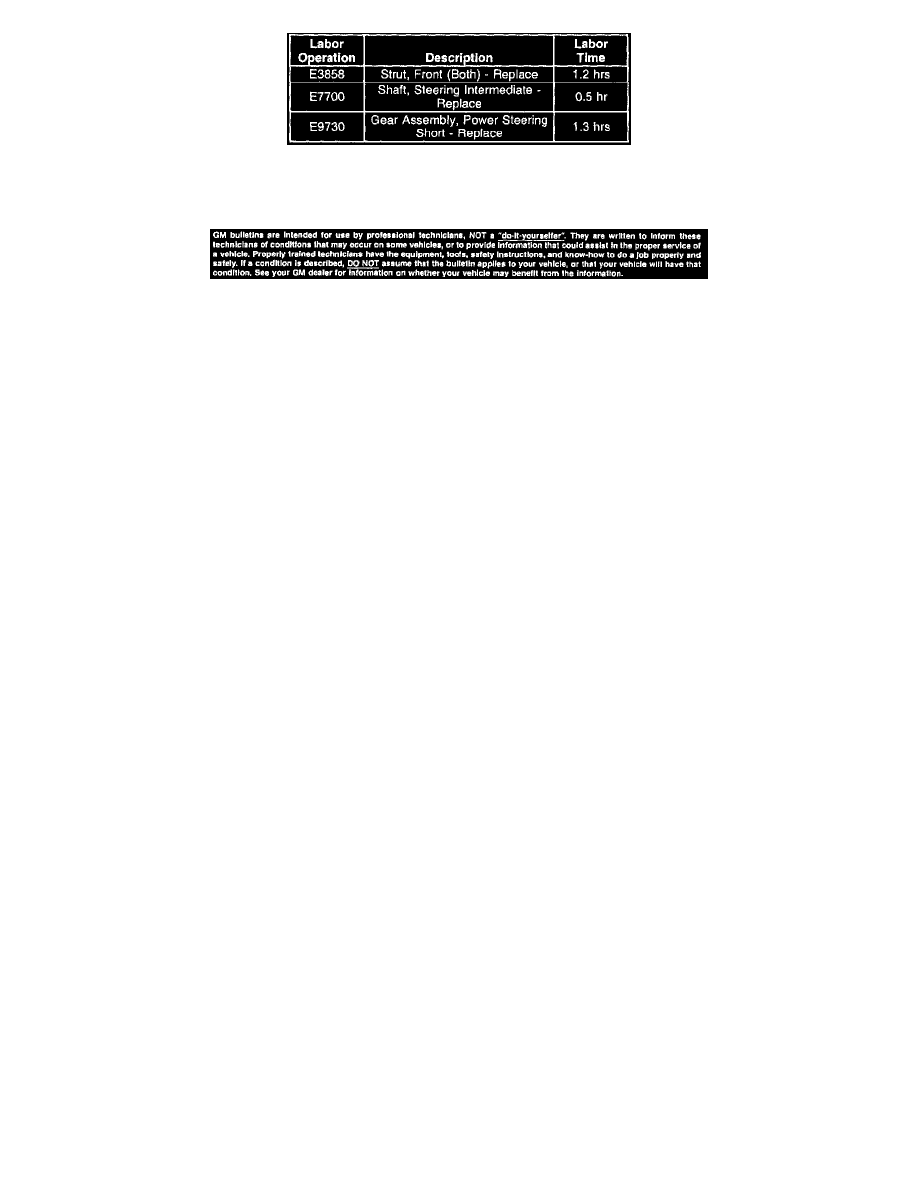Grand Prix V6-191 3.1L VIN M SFI (1998)

WARRANTY INFORMATION
For vehicles repaired under warranty.
Disclaimer
Whine/Whistle/Tone at 32 km/h (20 mph) w/Slight Steering Input
WHINE/WHISTLE, OR TONE AT 32 KM/H (20 MPH) WITH SLIGHT STEERING INPUT (MAGNASTEER (R) ONLY) - (1998 BUICK REGAL
GS, 1998 OLDSMOBILE INTRIGUE)
A whine or whistle may be heard in the passenger compartment of the vehicle. The tone may resemble a test tone and is most noticeable at 32 km/h (20
mph) with slight steering inputs. The noise originates in the Magnasteer (R) Variable Assist Steering Gear.
Important: For the Buick Regal, this condition applies only to a two month production of the GS model. During that time, the Oldsmobile Intrigue
intermediate shaft was substituted for the Buick part. Check the concerned vehicle for a multi-splined intermediate shaft in place of the standard
DOUBLE-D style shaft. Replace the splined shaft as instructed under "A Clunk that can be produced, both when the engine is running and when it is off"
in this bulletin. Replace the shaft regardless of it's date code.
-
To diagnose this condition, disconnect the Magnasteer (R) Variable Assist (MSVA) harness (at the MSVA pigtail) from the steering gear and test
drive the vehicle again. If the noise has disappeared, then the MSVA system is the source.
-
To correct this condition, replace the Electronic Brake and Traction Control Module with a revised module (P/N 9353511). Refer to the Labor
Time Guide for applicable operation number and time allowance.
A Clunk Produced When the Engine Is Running, NOT When It's Off
A CLUNK THAT CAN BE PRODUCED WHEN THE VEHICLE'S ENGINE IS RUNNING BUT NOT WHEN IT'S OFF (1998 BUICK REGAL GS,
1998 OLDSMOBILE INTRIGUE)
This type of noise is likely to be a steering gear condition; specifically too much clearance between the seal on the power piston and the groove that the
seal rides in. This excessive clearance lets the piston seal knock inside the groove during turns.
-
With the vehicle stationary and the engine running, turn the steering wheel rapidly back and forth over it's center position. Complete a cycle of
both directions about once a second. The wheel must be turned this quickly in order to bring about the noise. Next, repeat this rapid turning over
center with the engine off.
-
If the clunk was present with the engine on, but not when turned off, the rack may be the source. Verify the date of vehicle manufacture. This
condition was corrected in production by February 1,1998. If the vehicle is older then this date and has not had a steering rack replacement,
replace the rack. If the vehicle is newer than February 1,1998 refer to the applicable Service Manual and follow the normal diagnostic procedures
before changing the rack.
A Clunk Produced When the Engine Is Running and When It's Off
A CLUNK THAT CAN BE PRODUCED BOTH WHEN THE ENGINE IS RUNNING AND WHEN IT'S OFF (1998 BUICK REGAL, 1998
OLDSMOBILE INTRIGUE)
Important: The above condition applies only to a two month production run of the 1998 Buick Regal. During this period, the splined intermediate
shafts were installed in place of the standard DOUBLE-D style shaft. These vehicles were all equipped with the early version of the splined shaft which
is prone to the clunk noise. If a Buick Regal with this condition is encountered, replace the shaft with the DOUBLE-D style that is designated in the GM
Parts Manual as original equipment.
This type of clunk is likely to be caused by the intermediate shaft. This clunk may be caused by too much clearance between the splined inner and outer
parts of the slider joint. The additional clearance allows them to knock against each other during turns.
-
The correction is to replace the intermediate shaft with one built since the middle of October, 1998.
